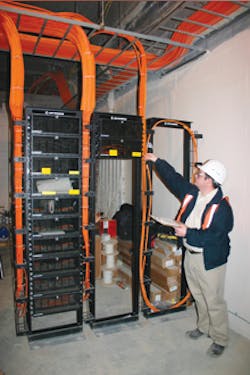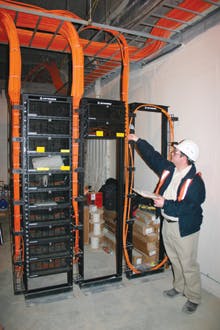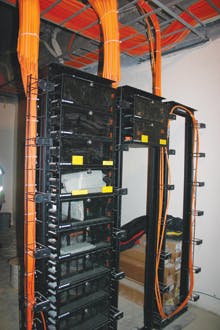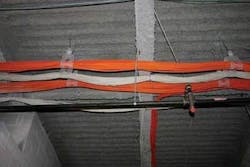Recable the Titans with a zone solution
by Carol Everett Oliver
The high school made famous on the silver screen is moving to a new facility, and integrating zone-cabling solutions with armored fiber-optic cable.
Remember the Titans, a movie released in 2000, focused on student integration in 1971 at T.C. Williams High School in Alexandria, VA. At that time, three area high schools were combined into one campus-T.C. Williams High School-to achieve desegregation. This consolidation brought together faculty and students from different ethnic and social backgrounds. The heart of the film is on the relationships extending from the combined multi-racial football team members and their coaches out to the community, which depict the “sign of the times.”
Today, the real T.C. Williams High School, built in 1965, is being replaced with a brand new, state-of-the-art high school complex. And with this updated campus comes a new meaning for the term, “integration.”
The design of the new 480,000 square-foot facility includes an integration of fiber and copper cabling to provide a unique network infrastructure for advanced data capabilities for the students and faculty, as well as services to the community, including a planetarium, day care center, and expanded meal servicing.
The cabling system consists of an extensive fiber-optic backbone and distribution system from one server room to multiple zone boxes; fiber-optic cable is the medium for the long runs to the zone boxes. From each zone box, copper horizontal cable provides data and video applications. Voice cabling was separately homerun from the server room directly to the outlets.
Designing and building the new school, which is adjacent to the existing school, took a significant amount of coordination among all the contractors-from the general contractor, Hensel Phelps Construction Co., to the low-voltage wiring group, M.C. Dean, Inc. The school consists of three floors and three wings of classrooms, labs and administration, as well as open areas, such as a central living laboratory.
Designing to LEED
This facility also complies with the U.S. Green Building Council’s Leadership in Energy and Environmental Design (LEED) rating program to achieve ecological efficiencies, such as water and energy. The LEED Green Building Rating System is the nationally accepted benchmark for the design, construction, and operation of high performance “green buildings.” LEED gives building owners the tools needed to have an immediate and measurable impact on their buildings’ performance. It promotes a whole-building approach to sustainability by recognizing performance in five areas of human and environmental health: site development, water savings, energy efficiency, materials selection, and indoor environmental quality.
In fact, a new report, prepared by Capital E (www.cap-e.com), “Greening America’s Schools Costs and Benefits” (October 2006), documents the financial costs and benefits of green schools compared to conventional schools, and demonstrates that a “greening” school design provides an extraordinarily cost-effective way to enhance student learning, reduce health and operational costs and, ultimately, increase school quality and competitiveness.
For the T.C. Williams High School construction project, Hensel Phelps Construction Company integrated the “whole building” design practices into their design. A 450,000-gallon underground cistern was installed to collect rainwater from the building’s roof to store it for toilet flushing, air-conditioning and irrigation. A roof garden cleanses roof-runoff before draining to the storm sewer and provides a living laboratory for students.
Space efficiency with armored cable
While adherence to the LEED program will result in more-efficient water and energy usage, these unique features created a challenge for planning cable pathways and delivery of both the electrical and telecommunications services. Moseley Architects designed a zone cabling environment, which allows all of the main data and voice terminations to be housed in one main server room. From there, the data distribution cable, or backbone, consisting of 12-strands of fiber-optic cable, is pulled to the zone boxes, which are housed in the ceilings within the classrooms or hallways.
“The main design driver was all about space efficiency, including honing the pathways to minimize the cable bulk and eliminate intermediate termination closets,” states Douglas Stanley, RCDD, telecommunications designer with M.C. Dean, Inc. (www.mcdean.com).
The one main telecom closet, also known as the server closet, is located on the second floor of the “B” wing. Instead of running a backbone system to several telecom closets, multiple runs of fiber-optic cable were pulled to zone boxes to save valuable floor space.
“The original design included the zone boxes fed by conduit occupied with standard 62.5-µm fiber-optic cables,” says Luigi Prezioso, manager of the telecommunications group for M.C. Dean, Inc. Protecting fiber cables within the plenum space has traditionally meant using costly conduit or innerduct. “By working with the city, the architects, and Hensel Phelps, we went one step further to save even more space by specifying ArmorTek from Berk-Tek, which is an armored jacketed cable, which totally eliminates the conduit while providing excellent protection of the fibers,” notes Prezioso.
“Additionally,” Prezioso continues, “armored fiber has been gaining popularity in riser and plenum spaces due to its inherent qualities, such as smaller size, extraordinary strength, flexibility, easier and faster installation over conventional methods-which includes installing a conduit and feeding the cable through it.”
In addition to saving space, the ArmorTek helped with the overall project schedule, saving time by reducing the conduit installation, and in pulling the cable to each location as well as in the termination procedures in the closet.
“Like most installations, the contractor likes the cabling to be installed from the top floor down,” says Prezioso. “Since the third floor was scheduled to be completed first and we didn’t want to slow up the schedule by having to wait on the installation of the conduit, the ArmorTek was the perfect solution. Obviously, the armored fiber-optic cable helped us simplify the schedule and conduct multiple activities simultaneously, which allowed us to meet our deadline. But it also helped the customer save real estate in the plenum areas.”
All fiber-optic cable was terminated into Ortronics’ (www.ortronics.com) OptiMo fiber cabinets in the one server room on the second floor. “Wit armored cable, it can be pulled all the way into the rack, stripped at the entrance of the fiber cabinet and safely terminated,” explains Rafael Rosa, telecommunications lead technician for M.C. Dean, Inc.
Zoning out
Most of the ArmorTek was pulled through the hallway drop ceilings and then fed into zone boxes, or consolidation points, in the classrooms; however, because the third floor had top side windows along the outer hallways to provide natural light, the fiber distribution cabling had run through the classroom ceilings. This had to be carefully pre-planned so that it would not conflict with other low-voltage cable services in the same space, such as lighting, audio/paging and security applications.
“Fiber provides better immunity interferences, such as EMI and other signal degradation caused by close proximity to these cables,” adds Rosa.
Although the original TIA/EIA-568-A standard for telecommunications cabling specified direct runs from the closet to the workstation outlets, Telecommunications Systems Bulletin TSB-75 Additional Horizontal Cabling Practices for Open Offices provided expanded guidelines for horizontal cabling. TSB-75 allows a point of connect and disconnect in the open office between the telecommunications outlet and the telecommunications closet. Zone cabling was originally made popular as a flexible alternative to open offices. Since the publication of TSB-75, the zone cabling concept has become popular in other environments, such as schools and data centers, and is not for just open offices anymore.
With zone cabling, distribution cables (also called “feeder” cables) are run from the telecom closet to a series of consolidation points to “feed” a cluster of workstations. This layout eliminates additional intermediate closets, as the termination field is located either in the floor or in the ceiling’s zone boxes within 15 meters of the workstation outlet. This topology also makes it easier to make cable changes between the short runs from the consolidation point to the outlet, instead of throughout the entire horizontal run back to the wiring closet. It cuts down on installation time, labor, and material costs, and can result in significant cost savings over the life of the cabling system.
Zone cabling was selected for space savings (by eliminating closets), and due to the extended cable run lengths. “Since the design included horizontal distribution runs from the server room to the data outlet that were well beyond the allowable 90-meter limitation that industry standards set for copper cable, we used fiber,” says Stanley. “With fiber, we could extend the runs up to 300 meters, if needed.”
Instead of having multiple closets with racks and multi-port patch panels taking up valuable class, hallway or lab space, 141 consolidation boxes were located in the ceiling. One zone box could service one to two classrooms, depending on the number of outlets needed. A typical classroom would require seven data ports, whereas lab and administration areas would require up to 40.
Connecting the dots
Each zone box measures 24 x 24 x 14 inches-approximately the same size as a ceiling tile-and houses the active and passive connectivity as well as patching fields to convert the distribution of services from fiber to Category 5e copper (including a switch and an Ortronics Clarity5E 24-port copper patch panel for the Category 5e cable).
“It’s as easy as connecting the dots,” claims Prezioso. “There are basically five rack spaces inside the zone box. A bracket holds the switch, which easily slides in front of the door. The fiber cables are brought into the zone box to make fiber cable termination simple. On the top is the copper patch panel with cable managers to make the transition between the fiber and the copper, neat and organized. Berk-Tek’s LANmark-350 Category 5e cable is punched down in the back of the copper patch panel and goes directly to the workstation outlet through a conduit in the wall.”
When added up, there are a total of 3,384 SC fiber terminations, 1,602 total outlets, and 2,377 Category 5e jacks. The data system is a warranted NetClear GT (enhanced Category 5e) system from Berk-Tek and Ortronics/Legrand, which guarantees the installation workmanship and products for the entire channel--from the patch panel to the Ortronics Clarity5E TracJack workstation outlet.
“For the voice, we ran separate homeruns of Berk-Tek’s Category 3 to each voice outlet, which totaled35 miles of voice cabling,” explains Stanley. “Since there were approximately 450 voice outlets, we felt that delivering a Category 3 to each voice workstation was cost-effective.”
Graduating up
Because of the fiber backbone and ease of accessibility to the zone boxes (or CPs), the horizontal cable can easily be upgraded in the future for higher-bandwidth applications, on an as-needed basis. In addition, they can eventually eliminate the Category 3 runs for voice, and VoIP can be brought over the data cabling by simply adding the electronics connecting through the CPs to the workstations.
“That’s the beauty of the zone cabling topology-to allow upgrades without having to run cable throughout the building,” says Prezioso. “Minimum disruption is certainly a concern in all educational facilities.”
Adds Stanley, “Zone cabling eliminates downtime by minimizing network disruption and thereby maintains maximum network productivity.”
At T.C. Williams High School, and throughout the Alexandria City Public Schools system, is a Technology Integration Project-TIP-to increase student achievement through the full integration of technology as a tool for learning. By providing every student with a laptop computer, the school system has made technology as accessible as all other tools for learning.
To provide Internet access, the new T.C. Williams High School will incorporate a wireless system. The zone cabling layout will allow access points to easily plug into the patch panels in the CPs and be cabled back to the server room.
Like Remember The Titans, which won awards and accolades for the screenplay and actors, M.C. Dean, Inc. has been recognized for its collaborative and innovative design ideas and efficient cabling layout. Watch for the premiere of this new school this coming fall.CAROL EVERETT OLIVER, RCDD, is the marketing analyst for Berk-Tek, a Nexans company (www.berktek.com). She has written several cabling-industry design and installation articles, and can be reached at: [email protected]






